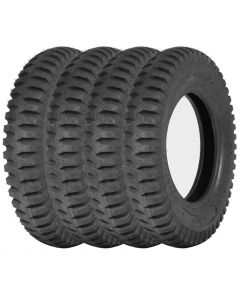Jeep Tyres
Willys Jeep Tyres

Ford Jeep Tyres
WW2 Military Willys Jeep
- The Majority of the Second World War Jeeps were equipped with 6.00 - 16 Crossply tyres or the slightly larger 7.00 - 16 Crossply tyres.
- The Willys Jeep MB fitted 6.00 - 16 NDT Bar Grip tyres.
- The Willys Jeep M38 (MC) and M38A1 (MD) fitted 7.00 - 16 Bar Grip tyres.
- These 6.00- 16 NDT Bar Grip tyres and the 7.00 -16 NDT Bar Grip tyres are ideal for classic WW2 military Willys Jeeps. They are fantastic tyres that keep the original tread design that gives you the authentic look, feel, and sound that the car would have in the period, all whilst being brilliantly sturdy for off-road and standard road use.
- These NDT tyres require innertubes when being fitted to a Jeep wheel, thankfully Michelin makes the fantastic Michelin 16F RET innertubes which are resilient and super strong tubes that are a perfect tube for a Jeep.
Civilian Willys Jeep Models
- The CJ-2A Jeep and its successors, the CJ-3A and CJ-3B also fitted 6.00 - 16 crossply tyres and we suggest the same 6.00 - 16 Bar Grip NDT tyres and 16 F RET tubes for these models.
For Willys Jeep tyre pressures, see our tyre pressure table below
Willys Jeep Tyre Pressures
| Model | Front (Psi) | Rear (Psi) |
|---|---|---|
| Jeep MB | 30 | 30 |
| Jeep MC | 25 (10 for mud, sand, or snow) | 25 (10 for mud, sand, or snow) |
| Jeep MD | 25 (10 for mud, sand, or snow) | 25 (10 for mud, sand, or snow) |
| CJ-2A | 26 | 28 |
| CJ-3A | 26 | 28 |
| CJ-3B | 26 | 28 |

A British Jeep in Normandy during D-Day
History of the Willys Jeep
With President Dwight D. Eisenhower dubbing the Willys MB Jeep "one of three decisive weapons the U.S. had during WWII" you can see why it has such a famed history. The Willys Jeep was built as a simple standardised design that would be easy to produce to make as much as possible for the US and its allies.
The MB Jeep and the Ford-built GPWs would be used by all of the allies in WW2, and a great marker of just how many were used is the comparison to Volkswagen's Kubelwagen, the Nazi's counterpart to the Jeep. Russia was sent 50,000 Jeeps for aid in their homeland, the Nazis produced just over 50'000 Kubelwagens in total. The Jeep was so useful in the war as it replaced what was still large reliability on horses and other working animals which were used as cavalry, supply trains, or transport pre ww2. Following this replacement, the Jeep vastly improved the amount of work done, and the ability to create various field modifications meant that the Jeep was incredibly multifunctional, finding use as a mechanized and motorized infantry unit, ambulances, anti-tank units, and even as tanks themselves in some instances.
The Jeep has gained such a cult following due to its usefulness in the war as well as its resilience, and its ww2 success led to the CJ Civilian Jeep line. These were loved as they almost served as a metaphor for post-war peacetime, sold in bright colours, these war machines had turned into farm equipment and weekend family-trip-out cars.

The military successor to the MB Jeep was the MC Jeep aka the M38. It was built as a military version of the Jeep CJ-3A for use in the Korean war and the Vietnam war as well as the Lebanese and Laotian Civil Wars. Ford was not involved in the production of the MC Jeeps however Ford of Canada did manufacture 2,800 Jeeps for use in the Canadian Armed Forces in 1952.
The MD Jeeps took over in 1952 and were procured by the U.S military from 1952 until 1957, after '57, purchases were limited to the U.S. Marines, who received models with slight variations from other military branches and the US Army adopted the Ford M151 Jeep in 1960. This Jeep had a much more rounded body than prior design than prior models, specifically, it was equipped with rounded wheel arches and a hood that would be adapted into the CJ-5 and later civilian Jeep models too.
Today these vehicles have a cult enthusiast following, many of whom are US veterans. There are also a variety of historic military vehicle groups that contain Jeep enthusiasts too, there are many reasons people love these vehicles, the remarkable engineering, the aid in the war effort, and the versatility are just three reasons why people love the Willys Jeeps so much.









